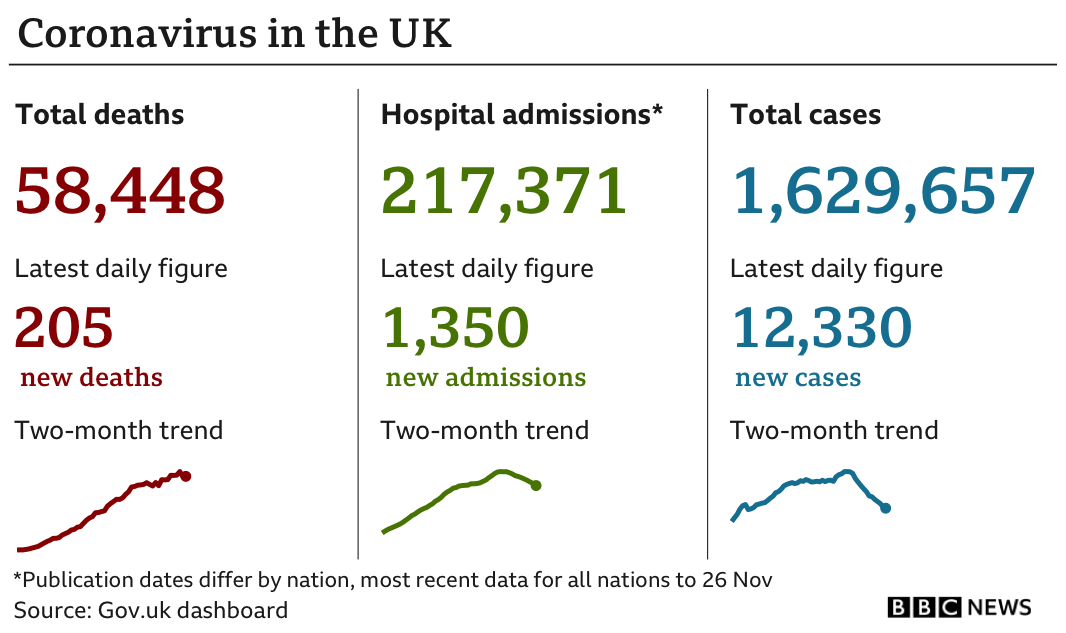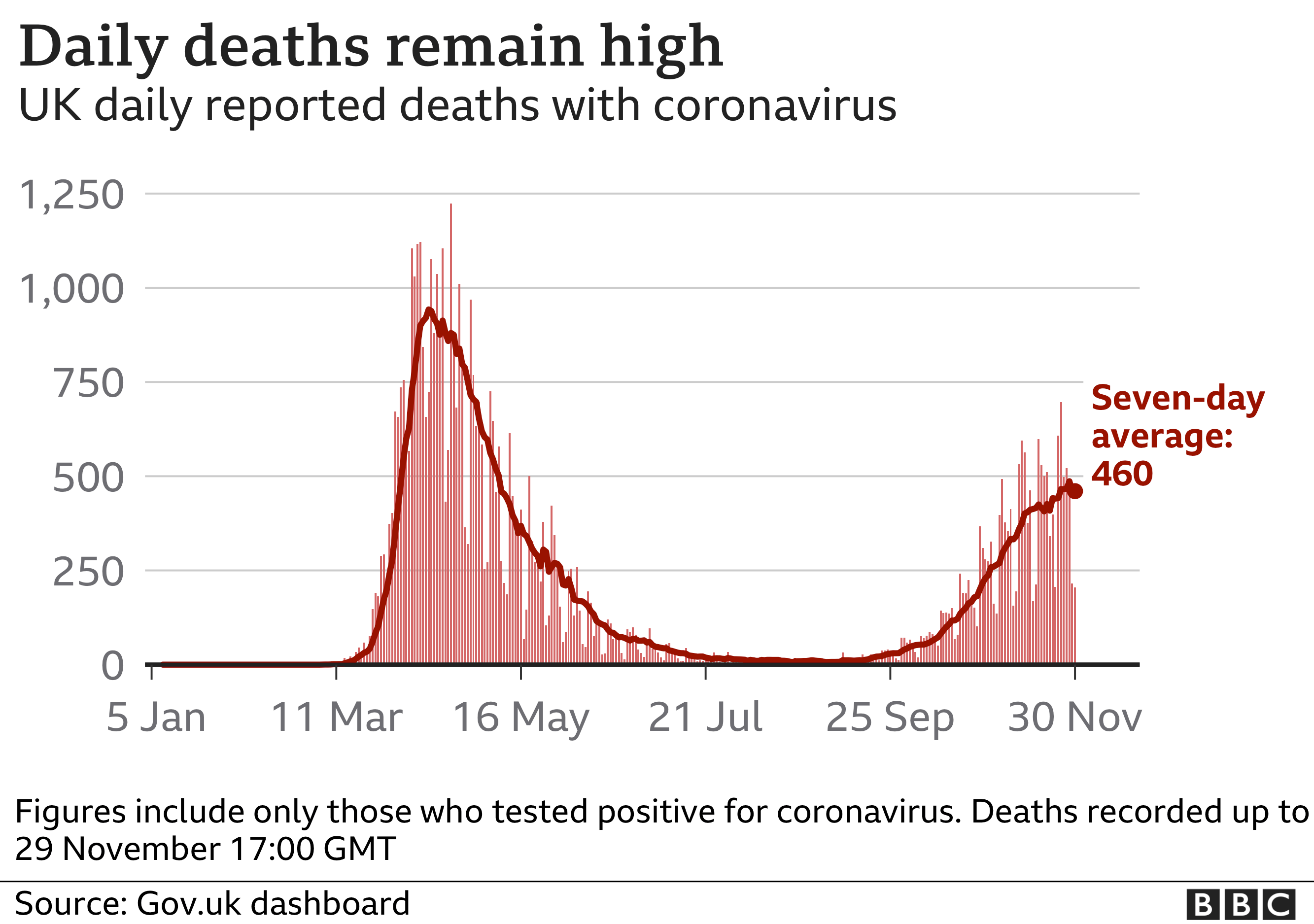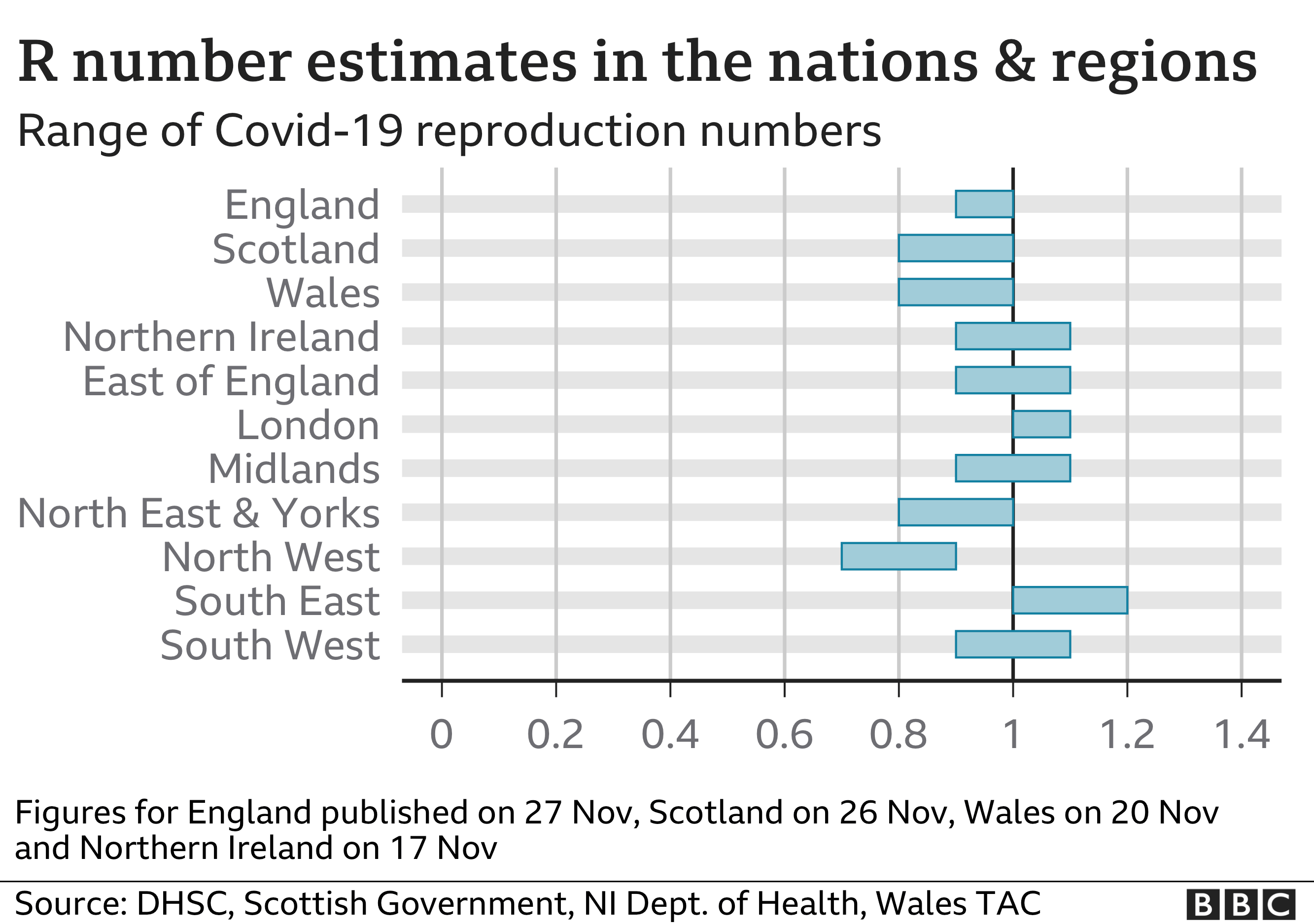
Covid-19 in the UK: How many coronavirus cases are there in your area?
There have been more than 1.6 million confirmed cases of coronavirus in the UK and nearly 60,000 people have died, government figures show.
However, these figures include only people who have died within 28 days of testing positive for coronavirus and other measures suggest the number of deaths is higher.



Find out how the pandemic has affected your area and how it compares with the national average:
How many cases and deaths in your area?
Enter a full UK postcode or council name to find out
Type in 3 or more characters for results.
If you can't see the look-up click here.

New cases falling
After the first peak in April, cases started rising again in July, with the rate of growth increasing sharply in September and October, before falling again in the past two weeks.
On Monday, the government announced a further 12,330 confirmed cases.
It is thought the infection rate was much higher during the first peak in spring, but testing capacity at the time was too limited to detect the true number of daily cases.


The data for cases can also be broken down by region and comparing the change in those figures by week gives a sense of where there has been a recent increase in newly-reported infections.


Coronavirus infections in England have fallen by about a third during lockdown, according to a major study carried out by Imperial College London.
While some of the worst-hit areas saw the biggest improvements, cases have remained relatively high across England, according to the React-1 study, which is based on tests of more than 100,000 people between 13-24 November.
The latest figures from the Office for National Statistics (ONS), suggest about one in 185 (16,400 people) in Wales had the virus in the week ending 21 November.
In Northern Ireland rates are thought to be decreasing at around one in 145 people (about 12,700 people), while in Scotland, the figure was one in 115 (about 45,700 people).

Daily deaths have risen
The average number of daily deaths began to rise again in September, following the first peak in April.
On Monday, the government announced a further 205 deaths.
Of these, 189 deaths were in England, 10 in Northern Ireland, three in Scotland and three in Wales.

UK coronavirus cases up by 12,155 on Sunday

Rules were amended over the summer to include deaths in the coronavirus total only if they occurred within 28 days of a positive test. Previously in England, all deaths after a positive test were included.
England has seen the majority of UK deaths from Covid-19. Using the 28-day cut-off, there have been more than 50,000.

Hospital admissions vary around UK
Although hospital admissions for Covid-19 remain below the levels seen in the spring, there are big regional disparities.
The North West, North East and Yorkshire, and Midlands have seen the highest number of admissions but the situation in all three now appears to be improving.



Where are cases rising the most?
Cases have risen across large parts of England, with other spikes in areas of Scotland, Wales and Northern Ireland.
The red areas on the map below are those currently seeing the highest number of cases per 100,000 people.
Coronavirus across the UK
Tap or click to see how many cases per 100,000 in the latest week

National public health bodies. Map made with Carto
Restrictions have been tightened across the UK in an effort to tackle the number of rising cases.
In England, each local authority will be placed in one of the new three tiers when the national lockdown ends on 2 December.

Wales has announced a range of further measures including a ban on pubs, restaurants and cafes serving alcohol from Friday. Other restrictions remain in place. In Northern Ireland, a further two-week "circuit-break" lockdown began on 27 November.
Scotland has a five-tier system of alert levels with different measures in place in different parts of the country.

UK leaders have agreed to allow up to three households to meet indoors during a five-day Christmas period of 23-27 December.


- TESTING: What tests are available?
- JOBS: What is the job support scheme?
- SYMPTOMS: What are they and how to guard against them?
- GLOBAL TRACKER: Where are the virus hotspots?
- YOUR QUESTIONS: We answer your queries

Overall death toll could be more than 70,000
When looking at the overall death toll from coronavirus, official figures count deaths in three different ways.
Government figures count people who tested positive for coronavirus and died within 28 days.
But there are two other measures.
The first includes all deaths where coronavirus was mentioned on the death certificate, even if the person had not been tested for the virus. The most recent figures suggest there had been more than 66,000 deaths by 13 November.


The second measure counts all deaths over and above the usual number at the time of year - that figure was more than 73,000 by 13 November.
The most recent figures available from the ONS are for the second week of November, which show there were 13,972 deaths registered in the UK.
Some 2,838 of these deaths involved Covid-19 - up from 2,225 the week before.
Deaths normally do rise at this time of the year, but the data from the ONS and its counterparts in Scotland and Northern Ireland show the second wave of the virus has pushed the death rate above the average seen over the past five years.
Overall, the figures are still well below the peak of 9,495 deaths recorded in a week, reached on 17 April.



What is the R number in the UK?
The "R number" is the average number of people an infected person will pass the disease on to.
If R is below one, then the number of people contracting the disease will fall; if it is above one, the number will grow.

The government's current estimate for the R number across the whole of the UK is 0.9 to 1.
The estimate for England is 0.9 to 1, while for Scotland it is 0.8 to 1. The estimate for Wales is 0.8 to 1 and in Northern Ireland it is 0.9 to 1.1.
The government has said in the past that the R number is one of the most important factors in making policy decisions.


